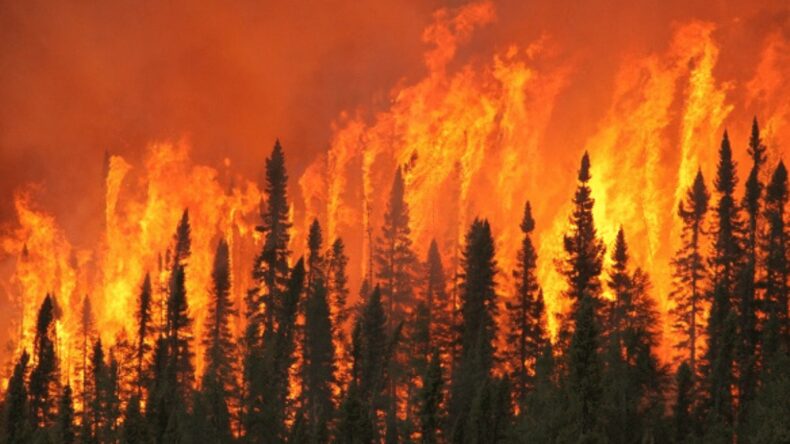In 2021, 1.76 billion metric tonnes of CO2 were emitted by the burning trees of the boreal forests spread across North America and Eurasia.
Table of Contents
Wildfires in the regions of boreal forests that are spread across the northern latitudes of the globe have been emitting record-breaking levels of planet-heating pollution in the form of CO2 (carbon dioxide) in rapidly increasing amounts, according to a study.
The study was published in Science by a team of international researchers that was led by Earth system scientists at the University of California, Irvine.
Generally, boreal wildfires make up 10 percent of wildfire-related carbon pollution globally. However, according to the study, this changed in 2021 as their contribution was raised to 23 percent. The extreme heatwaves and droughts in Canada and Siberia helped intensify the fires.

Image Source: CNN
In the same year, global energy-related CO2 emissions reached a peak of 37 billion metric tonnes, setting a record.
Professor of earth system science at the University of California, Steven Davis, the study’s author, believes that the boreal forests may be a carbon time bomb.

Image Source: UCI News
He also stated that in 2021, nearly twice as much CO2 was released by boreal wildfires as by global aviation, and if this becomes the new normal, then stabilising the earth’s climate might become even more challenging.
According to researchers led by scientists from Tsinghua University, China, the boreal forests were overlooked due to tropical forest fires, which were a result of deforestation, even though the boreal forests were under threat since the Arctic region has been warming up at a faster rate than the rest of the world.
Boreal forests
These are the world’s largest land biomes, which are spread across huge swaths of Canada, Alaska, and Russia. These forests grow in high-latitude environments where freezing temperatures are observed for six to eight months.

Image Source: Boreal forest Facts
Since the layers of snow and ice are melting because of global warming, the northern regions of the earth are warming up at a higher rate than the equatorial regions. Because of this, these forests are one of the fastest-warming biomes on earth.
According to the study, these are carbon-dense forests. Therefore, they release 10–20 times more carbon pollution, which heats the planet, for each unit burned by wildfires than any other ecosystem.
How the Team Measured CO2 Levels
Measurement of the number of emissions is necessary to understand the effects of certain events on the environment. However, measuring CO2 emissions was difficult due to the abundance of long-lived CO2 in the environment.
The researchers overcame this hurdle by monitoring CO (carbon monoxide), which was released into the atmosphere during fires. CO remains in the atmosphere for only a few weeks before being oxidised into CO2. Therefore, if scientists detect abnormal amounts of CO in the atmosphere, then that acts as evidence of fires.

Image Source: University of Toronto
The team reconstructed the changes in global emissions of fire CO2 from 2000 to 2021 by combining the reading of CO from the MOPITT (Measurement of Pollution in the Troposphere) satellite instrument with the wind speed and fire emissions datasets.
Results
It has been observed that the CO2 emissions from wildfires have been increasing gradually since 2000. 1.76 billion metric tonnes of CO2 were released into the atmosphere from the boreal wildfires across North America and Eurasia in 2021, which is 150 percent higher than the annual mean emissions of CO2 between 2000 and 2020.

Image Source: NASA
According to the researchers, wildfires are getting worse every year due to climate-fire feedback. This means that the CO2 emissions warm the planet, which creates conditions that further lead to more wildfires and therefore more emissions.
It was observed that boreal fires, along with other climate drivers, increased annual mean temperatures and short-lived heatwaves.
It was found that areas with large tree cover fractions and higher northern latitudes were particularly vulnerable.
What Can Be Done?
According to David, 80 percent of the CO2 emissions can be recovered through vegetation regrowth, but the rest, 20 percent, has been lost to the atmosphere in an almost irreversible way.
It is up to us humans to find a method or way of life that helps in removing carbon from the air or a way to cut down our production of atmospheric CO2. As this leads to heat pollution on the planet, which leads to more fires, the cycle continues.
Philippe Ciais, a co-author at Université Paris-Saclay, stated that Russia is home to the world’s largest boreal forest, but since Russia’s invasion of Ukraine has been going on for a year, scientific relations have been ruptured, and several might be lost before the data from the boreal forests of Russia and Siberia is received.













